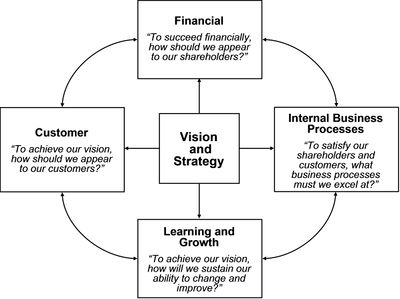Balanced Scorecard
The Balanced Scorecard (BSC) is a strategy performance management tool - a semi-standard structured report, supported by design methods and automation tools, that can be used by managers to keep track of the execution of activities by the staff within their control and to monitor the consequences arising from these actions.[1]
It was originated by Drs. Robert Kaplan (Harvard Business School) and David Norton as performance measurement (see What is a KPI?) framework that added strategic non-financial performance measures to traditional financial metrics to give managers and executives a more 'balanced' view of organizational performance. While the phrase balanced scorecard was coined in the early 1990s, the roots of this type of approach are deep, and include the pioneering work of General Electric on performance measurement reporting in the 1950’s and the work of French process engineers (who created the Tableau de Bord – literally, a "dashboard" of performance measures) in the early part of the 20th century.
Key Characteristics of the Balanced Scorecard
The critical characteristics that define a balanced scorecard are:
- Focus on strategy
- Key Performance Indicators
- Financial and Non-Financial Metcis
Balanced Scorecard Perspectives[2]
The balanced scorecard suggests that we view the organization from four perspectives, and develop metrics, collect data and analyze it relative to each of these perspectives:
- The Learning & Growth Perspective
This perspective includes employee training and corporate cultural attitudes related to both individual and corporate self-improvement. In a knowledge-worker organization, people, the only repository of knowledge. are the main resource. In the current climate of rapid technological change, it is becoming necessary for knowledge workers to be in a continuous learning mode. Metrics can be put into place to guide managers in focusing training funds where they can help the most. In any case, learning and growth constitute the essential foundation for the success of any knowledge-worker organization. Kaplan and Norton emphasize that 'learning' is more than 'training'; it also includes things like mentors and tutors within the organization, as well as that ease of communication among workers that allows them to readily get help on a problem when it is needed. It also includes technological tools; what the Baldrige criteria call "high-performance work systems."
- The Business Process Perspective
This perspective refers to internal business processes. Metrics based on this perspective allow the managers to know how well their business is running, and whether its products and services conform to customer requirements (the mission). These metrics have to be carefully designed by those who know these processes most intimately; with our unique missions, these are not something that can be developed by outside consultants.
- The Customer's Perspective
Recent management philosophy has shown an increasing realization of the importance of customer focus and customer satisfaction in any business. These are leading indicators: if customers are not satisfied, they will eventually find other suppliers that will meet their needs. Poor performance from this perspective is thus a leading indicator of future decline, even though the current financial picture may look good. In developing metrics for satisfaction, customers should be analyzed in terms of the kinds of customers and the kinds of processes for which we are providing a product or service to those customer groups.
- The Financial Perspective
Kaplan and Norton do not disregard the traditional need for financial data. Timely and accurate funding data will always be a priority, and managers will do whatever is necessary to provide it. In fact, often there is more than enough handling and processing of financial data. With the implementation of a corporate database, it is hoped that more of the processing can be centralized and automated. But the point is that the current emphasis on financials leads to an "unbalanced" situation with regard to other perspectives. There is perhaps a need to include additional financial-related data, such as risk assessment and cost-benefit data, in this category.

source: Sterling Strategies
Balanced Scorecard Generations[3]
The Balanced Scorecard Framework has evolved through three distinct iterations or generations:
- 1G Balanced Scorecard (1st Generation): The focus was on four aspects of performance namely, financial, customer, internal processes, and learning. This generation has been rendered obsolete by the subsequent 2nd and third-generation scorecards
- 2G Balanced Scorecard (2nd Generation): The focus was on measurement along strategic objectives. A visual linkage, called Strategy Map, highlighted the connection between these strategic objectives.
- 3G Balanced Scorecard (3rd Generation): This iteration of the balanced scorecard added a "destination statement" - what does "strategic success", or "strategic end-state", looked like along the journey to achieve strategic objectives? This allows for an estimation of the impact of management decisions before the die is cast. An invaluable technique for decision-making.
Some practitioners have proposed adding a leadership and management dimension to the balanced scorecard framework. Leadership creates the space for your people to perform. Management is making sure it happens. The fourth-generation approach explicitly describes where leadership and management play a role in performance management.
To support the leadership and management, Fourth Generation Strategy maps and Balanced scorecards have an “Organisational values” perspective. This underpins the existing four perspectives and incorporates the organization’s values as a driver of performance and change. Organizational values are represented by a lower, fifth perspective that underpins the learning and growth perspective."
See Also
- IT Balanced Scorecard
- IT Governance
- IT Strategy
- IT Strategy Framework
- IT Value Mapping
- Enterprise Architecture
References
- ↑ Balanced Scorecard Definition Wikipedia
- ↑ Balanced Scorecard Perspectives Balanced Scorecard Institute
- ↑ Balanced Scorecard Generations excitant.co.uk
Further Reading
- The Explainer: The Balanced Scorecard hbr.org
- Summary of the Balanced Scorecard Method valuebasedmanagement.net
- Conceptual Foundations of the Balanced Scorecard HBS/Robert S. Kaplan
